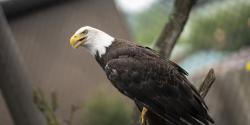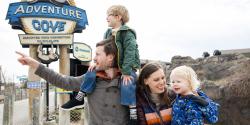With the recent completion of the Columbus Zoo's Sustainability Plan, which outlines efforts and initiatives to take place from now until 2040, I think it’s important to look back on what we have accomplished so far.
Waste Management
Between our three Columbus area attractions (the Columbus Zoo, Zoombezi Bay, and Safari Golf Club), 2,000 tons of waste can be created annually. Historically, when broken down into our waste streams, 8% was recycled, 72% was composted, and 20% ended up in the landfill.
Over the last 5 years, however, we have seen a dramatic change in our waste management practices! Starting in 2018 with:
- In the past, there was a 63.39% diversion rate with more than 1,237 tons of landfill-bound waste. In 2023, we saw a 79.54% diversion rate and only 452.63 tons going to landfill.
- Additionally, 1585.22 tons were composted, and 174.07 tons were recycled. This increased our diversion rate for 2023 to 79.54%! According to the EPA, the national average for a diversion rate is 32%, meaning we have almost a 2.5 times higher diversion rate than most of the country.
- We also have additional streams to handle the “non-traditional” materials such as styrofoam, electronics, plastic wrap, construction and demolition debris, and textiles.
But, that's not all! There's been other great "wins" for the Zoo:
- In 2023, we worked with the local company Advanced Drainage Systems to recycle 8,120 pounds of plastic from the Stings, Wings, and Playthings playground demolition. They took the plastic to be sorted, washed, and ground into flake. The flake is then blended and melted into pellets, and these pellets are then extruded into pipe designed to last over 100 years.
- U.S. consumers throw out about 20 billion plastic cups a year, with 93% of those ending up in landfills. We partnered with Ball in 2021 to become the first Zoo to introduce aluminum cups as an alternative to single-use plastic cups at our beverage locations. In addition to these cups being infinitely recyclable, they reduce the environmental impact of the new can or cup by as much as 80%.
- Since 2018, we have participated in the Plastic Free Ecochallenge, which takes place annually in July. Plastic Free Ecochallenge is a one-month challenge that makes refusing and reducing single-use plastics in our everyday lives fun, easy, and rewarding. Whether you're completely new to plastic-less living or a seasoned pro, you'll find new and exciting ways to propel you forward on your sustainability journey. With the help of participants, we’ve been able to avoid sending almost 1.3 million single use plastic items to landfill.
- Annually we participate in the SAFE program Gorillas on the Line. This recycling campaign encourages participants to recycle unwanted handheld electronic items. These devices contain coltan, a mineral found in the Democratic Republic of Congo under gorilla habitat. The money raised through this campaign is donated to two gorilla conservation projects that benefit Cross River gorillas in Nigeria and Cameroon and Grauer’s gorillas in the Democratic Republic of Congo. Nationally, 31 zoos and one teaching college participate in this campaign and have collectively gathered over 115,000 devices. The Columbus Zoo has contributed the 9th most, with 2,405 devices recycled so far.
Renewable Energy & Energy Efficiency
We have two solar arrays at the Columbus Zoo and Aquarium.
- The roof of the Suzie Edwards Conservation Education Classroom building features 165 solar panels. In 2023, these panels were responsible for generating 40% of the electricity needs for the building.
- We also have a ground mounted solar array located near our Polar Frontier region. This system comprises 308 panels and adds around 167,000 kWh of electricity back to the electricity grid each year. Between these two solar arrays, we annually generate enough electricity to power 34 homes for a year. In addition, as of June 2023, 25% of our electricity, around 5 million kWh, is generated through renewable energy sources.
Due to the massive impact the transportation sector has on annual greenhouse gas emissions from the US, accounting for 29%, we have begun the process of electrifying our fleet vehicles. Our first all-electric vehicle was purchased in 2022 and in 2023, and our catering department added two additional vehicles. We worked with the local organization Clean Fuels Ohio to do a fleet assessment and replacement plan for all our fleet vehicles with electric or other sustainable alternatives. In 2023, we introduced a fully electric engine in our popular North America train, a popular guest attraction that lets guests tour the region. This low-emission battery powered engine has replaced both the compressed natural gas and diesel engines that were previously in use.
In 2019, we identified more than 4,500 opportunities for lighting retrofits. As of 2024, almost all 610 acres of our Columbus parks have been converted from traditional light bulbs to energy-efficient LEDs. Research has shown that LEDs use at least 75% less energy, and last up to 25 times longer, than incandescent lighting. Through the generous support of AEP Ohio, we have been able to convert almost 3 million conventional holiday lights to LED lights for our annual Wildlights event. These LED lights use only a fraction of the energy traditional lights use, and they last up to 200,000 hours instead of the 26,000 hours of conventional lights.
Biodiversity
In 2023, we planted over 11 acres of pollinator habitats, which were designed to contain plants that provide food and shelter for animals such as bees, birds, butterflies, moths, wasps, bats, and other small mammals that are responsible for pollinating plants that support the local ecosystem and food web. According to the USDA, of the 1,400 crop plants grown around the world, i.e., those that produce all our food and plant-industrial products, almost 80% require pollinators to reproduce. More than 150 food crops, specifically in the US, depend on pollinators, this includes all fruit and grain crops. We also have several additional smaller scale pollinator gardens located throughout Zoombezi Bay!
Safari Golf Club has been certified as an Audubon Cooperative Sanctuary since 2018 and were recertified in 2021. They are one of the 2.7% of golf courses globally to achieve this status. This program helps golf courses enhance valuable natural areas and wildlife habitats, improve efficiency, and minimize the potentially harmful effects of golf course operations.
The Wilds is located on reclaimed mine land, making it difficult to grow many species of trees due to soil compaction and low nutrient availability. To combat these obstacles, The Wilds has planted nearly 700 acres of native prairies, to help change soil properties and provide the perfect habitat for pollinators and other wildlife. Nearly 10,000 seedlings have been planted since 2014 to improve the forest ecosystem and provide valuable research and information about the best techniques to establish trees and reforest on reclaimed grasslands. Over 46 acres have been arduously reforested by the Wilds ecology department through the process of replacing invasive plant species with native ones.
Wetlands boast the most biologically diverse ecosystems in the world, but they also are considered one of the most endangered. The Wilds has restored 20 acres into a wetland refuge. Several water related restoration projects have been in the works since 2014. Nearly 20,000 linear feet of stream and 100 acres of riparian buffer along Miller Creek have been restored.
How You Can Help
Hopefully a few of these awesome initiatives have inspired you to ask how you can help, below are a few ways to be sustainable at home!
- Save energy with energy efficient lighting. Compact fluorescent bulbs use around 20% of the energy to produce the same amount of light as an incandescent bulb and can last up to 10 times as long.
- Bring nature inside. Houseplants not only consume CO2 but can help purify the air by removing harmful chemicals for a healthier, more sustainable home.
- Support sustainable food systems and learn what foods are sustainable. If giving up meat is a no-go for you, you can still make that steak more sustainable by sourcing it locally from organic, grass-fed farms.
- Visit local farmer’s markets. Locally sourced produce travels about 27 times less distance than conventionally sourced produce. Local often means organic food that’s cultivated in-season, meaning you’re not supporting industrial-scale agriculture to produce crops unnaturally. Check out the National Farmers Market Directory to find a Farmers Market near you!
- Use the dishwasher. As strange as that may sound coming from me, dishwashers actually save water (up to 5,000 gallons a year with an efficient appliance). That at least makes everyone’s least favorite chore a bit better, especially when using eco-friendly dishwasher tablets.
- Tackle waste using the 5 Rs of zero waste. These are: reduce, refuse, reuse, recycle, and rot. Learning how to properly dispose of your waste can minimize the amount of product getting sent to landfills.
Lastly for a bit more inspiration here is one of my favorite quotes by Jane Goodall: “Each one of us matters, has a role to play, and makes a difference. Each one of us must take responsibility for our own lives, and above all, show respect and love for living things around us, especially each other.”









